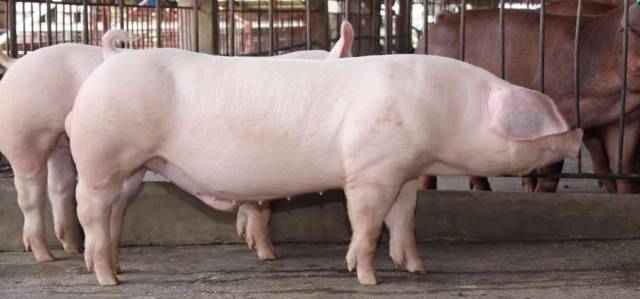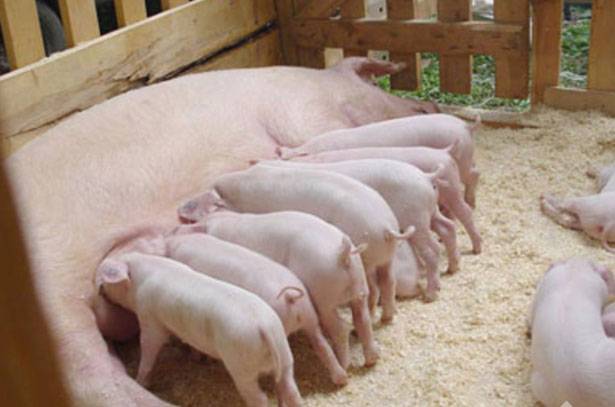Content
In recent years, pig farmers have become interested in bacon breeds. With proper care and feeding, you can get a large yield of meat products. The meat of bacon pigs is not too fatty and tasty. Of course, there are some specific features of raising animals.
Among breeds, which are purchased for fattening for meat - Landrace pigs. While pig farmers with extensive experience know how to care for animals and produce young animals, beginners often experience difficulties. We will try to answer the questions that novice pig farmers have about the features of fattening Landrace pigs.
Description
The Landrace pig breed is not new. By nature it is a hybrid, bred by Danish breeders more than 100 years ago. The parents were a Danish pig and an English white pig. From its ancestors, the Landrace pig took a good exterior and productive qualities.
Experienced pig breeders, looking at an animal or its photo, can immediately determine that it is a Landrace in front of them. They will never confuse them because they are well familiar with the descriptions of animals.
Features of the Landrace breed:
- On a long body, similar to a torpedo or a log, there is a small head. The ears are medium sized and drooping. In the video and photo it is clearly visible that they close their eyes.
- The neck is long, fleshy, the chest does not differ in width.
- The body of the pig is powerful, well-built, distinguished by a straight back and fleshy hams.
- The legs are short but strong.
- The wool is sparse and white. Pink thin skin shines through it.
According to their description, Landraces are slightly similar to the Duroc breed. These American pigs also have a strong body and a small head. But their fur is red-bronze in color and thick.
Characteristics
Landrace is a breed of meat pigs, characterized by high productivity. Pedigree animals are raised in many countries. Pigs are popular due to their meat with a small amount of fat. According to reviews from pig farmers, young animals gain weight very quickly, with an average weight gain of up to 0.7 kg per day.
What other advantages do Landrace pigs have? A large yield of meat products in a short time is one of the important advantages:
- an adult boar is 1 m 85 cm long, sows are 20 centimeters shorter;
- chest coverage for a boar is up to 165 cm, for a pig – 150;
- The weight of three-month-old piglets is about 100 kg, the boar is about 310 kg, the queen is 230 kg. Look at the photo what an adult Landrace boar looks like;
- upon slaughter, the yield of clean meat is at least 70%;
- Sows are fertile; one litter can have up to 15 piglets. They have good survival rate. A sow of the Duroc breed does not have more than 9 litters. Pigs of the Landrace and Duroc breeds are good mothers, as can be seen in the photo.
We will not remain silent about the shortcomings of the breed; they mainly relate to special conditions of keeping and choice of feed. But in general, if you look at the characteristics of Landrace pigs, they are profitable to keep for fattening.
Breeding Features
Raising a Landrace pig is not difficult if you know the conditions in which it can be kept and the diet. The fact is that animals are quite capricious. If you do not follow the rules for growing the Landrace breed, you may be disappointed.
Room
As experienced pig breeders note in their reviews, it is necessary to provide comfortable housing for animals of this breed:
- The barn in which pigs are kept must have a stable temperature of at least + 20 degrees. Drafts are not allowed.
- The litter needs to be changed constantly so that it does not become damp. You need to clean the pigsty at least every other day.
- Young and adult pigs do not survive well in high air humidity. If the pigsty is cold, you will have to install a heater.
- The room for Landrace pigs should be spacious, because heavy animals need a lot of space.
- If there is not enough natural light, you will have to take care of lighting, especially in winter.
Although the Landrace pig breed loves warmth, today livestock breeders have learned to raise them in regions with harsh climates. They only heat barns at very low temperatures. In addition, the pigsty must have deep, dry bedding.
How to prepare deep litter:
Despite the apparent slowness and large mass, representatives of the breed are distinguished by their mobility. Even adult pigs are not averse to frolicking.
If these requirements are not met, animals may become ill. At the first sign of discomfort, you should seek help from a veterinarian.
Feeding
Landraces are capricious pigs, they are very picky about food. What to feed the animals? The diet of animals should include dry, succulent feed and mixed feed. The feed is varied with hay, cake, pumpkin, various vegetables, and silage. Only a balanced diet allows you to get tasty lean meat.
Landrace and Duroc meat pigs are often raised free-range. Pasture keeping in spring and autumn provides animals with fresh grass, nettles, and clover.
For pigs, feed needs to be specially prepared. Kitchen scraps can be used, but must be boiled to kill pathogens. Adult animals are fed twice a day; they need up to 2.5 buckets of food per day. As for the nutrition of young animals, for the first three months food is given three times a day.
Landrace pigs are clean animals; they cannot be kept in a dirty pigsty; they must be bathed. If it is not possible to create a “pool”, in the heat you need to water them from a watering can.
Getting offspring
Pig farmers raise Landrace pigs to produce lean, tasty meat. Pedigree piglets are expensive; buying young pigs every time is unprofitable. Therefore, they breed sows to produce offspring at home. In order not to lose the quality of the breed, both parents must meet the characteristics. On large farms, Landrace pigs are often crossed with the Duroc meat breed. Mestizos are strong and hardy. They inherit the best qualities of their parents.
To get healthy, viable offspring, a pregnant sow needs to be fed separately from other animals. Her food should be nutritious, rich in succulent food.
Pregnancy in pigs lasts 114 days.
Landraces are large animals, and the uterus often experiences complications during childbirth and needs help. But that is not all. Piglets need to cut the umbilical cord and wipe with a dry cloth. The weight of piglets at birth is 600-800 grams.
Each piglet must be brought to the sow's nipples no later than 45 minutes after birth and fed with colostrum. This is a mandatory procedure; it must be performed even if not all of the offspring have been born. When a baby sucks milk, he not only receives the necessary microelements from mother's milk, but also reduces the pain of contractions in the mother. Newborn Landrace piglets should be placed under a heat lamp.
If there are weak piglets in the litter, they are either placed on the nipples each time, or transferred to artificial feeding. But this needs to be done for a limited time, otherwise there will be difficulties with regular feeding.
Landrace and Duroc sows take care of their offspring. They always have enough milk to feed piglets.
After all, the sow has a fairly large body mass and can accidentally suffocate the young. The piglets are immediately moved into a separate pen and released for feeding after 2-3 hours, when the queen has settled down.
In this state, she can eat her offspring.
For 28 days, the pig feeds the piglets with its milk. If there is not enough milk, the young animals are gradually transferred to regular fattening. The diet must include dairy products, bran, and vegetables. At 4 months the weight of piglets is more than 100 kg.
Reviews from pig farmers
Conclusion
Livestock breeders prefer to breed Landrace pigs, despite some difficulty in breeding. The meat of bacon pigs has excellent taste and is highly appreciated by gourmets. It is high in protein and low in fat. Pigs grow quickly, the yield of finished products is over 70 percent. As pig farmers note, keeping bacon Landraces for fattening is profitable.
















